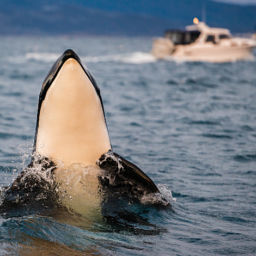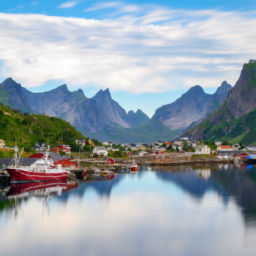Many miles north of the Arctic Circle is a breathtaking landscape of inky, black waterways, their depths contrasting starkly with the snow-dusted peaks reflected on the water’ surface. This is a land of extremes — Norway’s fjordlands, where fleeting daylight illuminates jagged mountains and whispering forests. Here the Northern Lights play like phantoms across the nighttime sky. It’s a realm that belongs to eagles soaring on invisible thermals and to the Tysfjord orcas, swimming beneath the surface of a glacial sea.
Orcas have visited these shores for many centuries. Prehistoric peoples documented their age-old presence with prehistoric rock carvings etched in the cliffs above Leknes. Visitors from all over the world flock to the fjordland municipality of Tysfjord, which has been the center of the seasonal Norwegian orca migration since 1990. Here you can see the orcas from any of the whale-watching vessels that operate in the area, and also — uniquely — snorkel beside them in the frigid waters.
To enter the orca’s world is to feel your existence align, however briefly, with that of the ocean’s greatest apex predator. Out on the water, you’re warm in your drysuit, even though the air feels as though it’s laced with ice. Your eyes scan the iron-gray waves, willing them to transform into whales. Other than the sound of the inflatable moving across the water, there is a stillness on the fjord.
Suddenly, where a moment before there was nothing but a vast expanse of sea, a great black fin appears. It slices through the water like a knife, all six feet of it silhouetted against the white foothills behind. A second, and then a third whale joins the male orca. A whole pod appears, their sleek, black backs surfing the waves in front of the boat in perfect synchrony. You have just enough time to register the way their breath hangs in the air like silver filigree before you hear the signal to enter the water.
As you slip over the side, the cold barely registers as you try to make sense of the underwater world. It takes a few seconds to focus on the surprising clarity of the jade-colored water, on the way it plunges blackly into the depths below. Thousands of fish scales fall like flecks of mercury through the water column.
Because the Arctic sun doesn’t rise above the horizon at this time of year, it is always twilight in this ocean. Then, suddenly in the gloaming, you see a flash of white; the water around you starts to throb with the sudden dart of a shoal of silvered fish, moving and arcing with such perfect choreography that they seem like a single entity. The shoal splits, and before you, unimaginably large, is your first orca. She looks directly at you, inquisitive. You realize that there are more whales in the water around you, appearing like ghosts from the underworld. You remember that their Latin name translates as “whales from the kingdom of the dead.”
As they morph out of the blackness below you, that makes perfect sense. Amazingly, although you are completely exposed and utterly vulnerable, you feel no fear: these are perfect predators, exquisite in their power and precision, and yet you know instinctively that they mean you no harm. Too soon, they are gone, and you are left to haul yourself as elegantly as possible into the waiting inflatable. The air is colder now as the last of the ephemeral daylight begins to fade, but you’re oblivious. Your heart is racing; as the surrealism of what you’ve just experienced sinks in, you aren’t sure whether to laugh or cry. You know one thing for sure — that in that moment, you’ve never felt more alive.
The Tysfjord Orcas
Encounters like these are the result of a natural phenomenon that’s only been happening for the last 27 years. The orcas of Tysfjord and the surrounding area are fish-eaters, feasting predominantly on the Norwegian spring-spawning herring. The whales follow in the wake of the herrings’ migration, wherein the fish travel from their spring spawning grounds in the south of the country to feed in the northerly waters of the Norwegian Sea during the summer months.
In the past, the herring spent the winter in offshore waters between Norway and Iceland. But in the late 1960s, overfishing decimated their populations. As a result, the herring altered their migration patterns. From 1987 onward, they began spending the winter sheltering in the northern fjords of Tysfjord, Ofotfjord and Vestfjord. From mid-October to January, up to 9 million tons of herring take up residence in the fjords. The herring spend the nighttime hours close to the surface, and dive en masse to depths of up to 1,640 feet during the day.
This daily migration into deeper water is presumably an attempt to escape predation by not only the orcas, but also by sea eagles, gulls and, of course, fishermen. The country imposed a moratorium on fishing in 1970 to allow herring stocks to recover; only in the 1990s did total allowable catch limits increase. The orcas, for their part, have developed a set of deadly fishing tactics, collectively known as carousel feeding. Therein, the whales separate a small school of herring and herd them back towards the surface. The whales work as a pack, circling the isolated fish and confusing them by flashing their white undersides and blowing bubbles.
When the herring reach the surface they have nowhere left to escape. The orcas slap the shoal with their flukes, stunning and immobilizing the fish. Unable to move, the orcas pick off the herring one by one. Sometimes the orcas also scavenge in the wake of the fishing boats in the fjord, catching the injured fish that fall through the fishermen’s nets. In 2004, as many as 1,500 orcas were reported to have visited Tysfjord; commonly, between 600 and 700 whales arrive in the wake of the herring each year.
There has been some change in the herrings’ migration patterns, and consequently the orcas’ behavior, since 2007. According to Orca Tysfjord, one of the first whale-watching operations in the area, fewer herring are arriving in the fjord, which means fewer orca sightings. However, in 2012, the operation discovered that the migration had simply moved slightly north. In 2014, they spotted orcas on every trip from the beginning of December to the middle of February. Neither are the orcas the sole reason to travel to the remotely beautiful fjordlands. Fin whales, humpbacks, porpoise and sea otters also take advantage of the herring glut. The mountains bordering the fjords are a nature-lover’s wonderland as well. Tysfjord and the surrounding area is one of the few places left on Earth where nature still reigns supreme, and to meet its most famous residents is truly a spectacular privilege.
When to go: Beginning of December to last week of February. Interactions depend completely on the orcas. You may be unlucky and not get in the water at all; you may encounter a curious pod that wants to interact for some time with snorkelers.
What to wear: Take warm clothing, thermal underwear, a waterproof jacket, sweater, warm/weatherproof footwear, headgear and gloves. You’ll snorkel in a full drysuit.
Average water temp: 40 to 42 degrees Fahrenheit (5 to 6 C)
Visibility: 65 feet (20 m)






